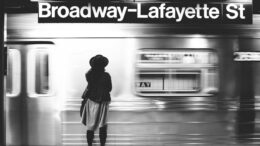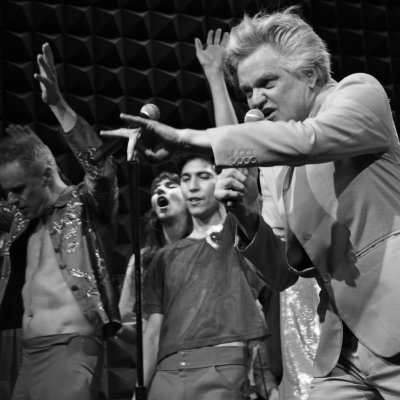I was trying to tell my story about saving the trees of the East River Park, destined for the chainsaws and bulldozers of the real estate moguls of New York. But our stage was just too close to the Broadway Lafayette station where Jordan Neely was murdered.
Jordan was killed four blocks from Joe’s Pub at the Public Theater, on the underground stage of the F Train, which squeezed and lurched into the Broadway Lafayette station on May 1 with Jordan on the floor in the chokehold of a marooned-in-macho former Marine named Daniel Penny. He snuck up behind Jordan and grabbed him as he was wailing, “I’m thirsty! I’m hungry! I’m tired! I’m fed up! I’m ready to die!”
Jordan Neely was a well-known busker, a street performer who perfected the moves of Michael Jackson, to whom he bore a strong resemblance. He was 30. Penny compressed his windpipe, and Neely was dead in minutes. The police of New York saw fit not to arrest Penny at first. He returned home to suburban Long Island as Jordan Neely went to the coroner, who ruled his death a homicide. The city erupted in protest, some of us even walking down tracks in the subway tunnel, stopping the trains.
Jordan was suffering emotionally and was unhoused for long periods. He needed our help, and we failed him as a city. That day Jordan was scary to Daniel Penny. He didn’t touch anyone or personally threaten any one person. But for many years anguished souls in the trains have been a part of living here.
Jordan Neely’s story and death swept through the city. At our May 7 show, after a week of still no murder charge and silence from our cop-mayor, we brought to the Joe’s Pub stage a bright red drum major’s coat, hung up on a light tree. This is the classic Michael Jackson costume that Jordan wore in his widely seen photographs, maybe with fewer gold braids.
At the end of our show, our director Savitri D invited the audience to come with us to the Broadway Lafayette station. We walked there, climate activists, arm in arm, chanting “Justice for Jordan.” Most of the audience came with us. We marched to the F Train platform where he died, following his red coat, which Savitri raised high on a long stick. Passersby joined us in our singing vigil.
There was something about that heaving rhythmic singing on that afternoon in the echoey tunnel… I don’t remember anything like it from years of shouting protests about extinction and climate change. The force of it, the anger, implacable refusal to let this continue, and then sadness, too, that this kind of violence spreading across the country, from children knocking on the wrong door to the insurrection of Jan. 6… This new kind of violence, can it be confronted with the sounds our bodies make? Can it be sung away?
In the United States, racist violence is never far from anyone, no matter what your issue might be. But progressive people do tend to choose an issue, and we can use it to narrow our lenses, as a defense against being overwhelmed by an overwhelming world. A person devoted to the cause of cruelty to animals might spend years opposing a Smithfield meat plant. Or it might be a Disney sweatshop in sub-Saharan Africa. Or palm plantations. Or redlining bank loans in the city.
And when you successfully raise an issue in the western mind, then institutions align with you and create your identity — like foundations, press, database outfits, your lawyer, etc. You’re labelled with your issue and you won’t escape. You are the “toxicity in beauty products” person, and that’s how you are defined or define yourself.
With our performance at the Public, such isolation was impossible. We could hear the trains rumbling underground. We could feel Jordan’s life and death flooding into the lyrics of our songs, into our stories of talking birds, invading machines, and subtitles we lend to superstorms. Our one message is that the Earth is a conscious being, with intelligence and feelings… Jordan moonwalked right through it.
One great failure in the “naming” of the Jordan Neely crisis by our city was what subways have become. Unmentioned in the killing’s trail of op-eds was the psychic environment in the train stations. That’s because of the narrowness of “issues” again. Public transportation is an issue, a necessary one to fight the dominance of fossil fuels, but you don’t hear anyone asking the question, “What happens to people in the psychic environment of the subway trains and stations?”
In fact the tunnels under the city vibrate with fear, and the unhoused and vulnerable are not the primary cause. Our train stations are cruel psychic experiments. There’s the glut of advertising to the point of torture; video screens large and small are jumping everywhere. You can’t escape the pressure of products. The faces of your fellow commuters glow with handheld games and TikTok and the Avengers and porn.
By the time the train pulls out of the station you are threatened by the happy professional voice announcing that post-9/11 militarized cops have lots of power down here. “The police would like to remind you that backpacks and large packages are subject to random search.” The intercom shares some common sense about leaning on the doors and walking between train cars but adds the ominous suggestions “Keep your possessions in sight at all times. Be alert!” — the thinly veiled NYPD fetish, the criminal inevitability they see in young Black males.
View this post on Instagram
The train begins to pull out of the station, and then here come the subway performers, vying for our exhausted eyes and ears. While the mariachi bands and drummer soloists and Jesus freaks might penetrate the already over-saturated sonic world, the more delicate artists — like a Doo-wop group with high harmonies from a threesome of soul stirrers, or a broke mother with her child pleading in a voice that doesn’t carry — their weak sound is wiped out. Jordan Neely though, moonwalking and smiling by, was some kind of pied piper.
But what happened to him? We know that his mother was murdered before he was 10 years old. But also, Sean Bell was shot at his Harlem wedding party when Jordan was 13, Freddie Gray died in the back of a Baltimore police vehicle when Jordan was 20, Eric Garner was unable to breathe in Staten Island and Michael Brown jaywalked in Ferguson and Tamir Rice was playing with his toy gun when Jordan was 21, Deborah Danner was shot in her bedroom in the Bronx when he was 22, Philando Castile of Minneapolis reached for his wallet when Jordan was 23, Stephen Clark waved his phone in his grandmother’s backyard when Jordan was 25… And then George Floyd, Brionna Taylor, Ahmaud Arbery and on and on and on.
For the many harmed and desperate people of color who brave the crazy environment of the subway to ask for help, the context is a nightmare, especially given the police warnings on the public address system which amount to threats.
Ten riders sat there with their iPhones, busy but paralyzed, as Daniel Penny choked Jordan Neely to death. What if they had stood up, all of them, accepting the task of defending a life? That’s what our singing that evening seemed to make possible, albeit too late. The soaring “Justice for Jordan” went up and up on the rhythms of clapping hands and harmonies. We didn’t feel like we were struggling to get from one issue to a second issue, from environmentalism to racial justice.
The volunteer gathering of strangers in the city was singing against a nightmare, singing down the injustice. We sensed we would be singing this song for a long, long time, and I like to think that more activism will come from it. Jordan danced and danced and danced as long as he could, and more dancers will grace our pavement and parks and our city will change.
![]()
The opinions expressed above are those of the author and do not necessarily reflect those of The Revelator, the Center for Biological Diversity or their employees.


